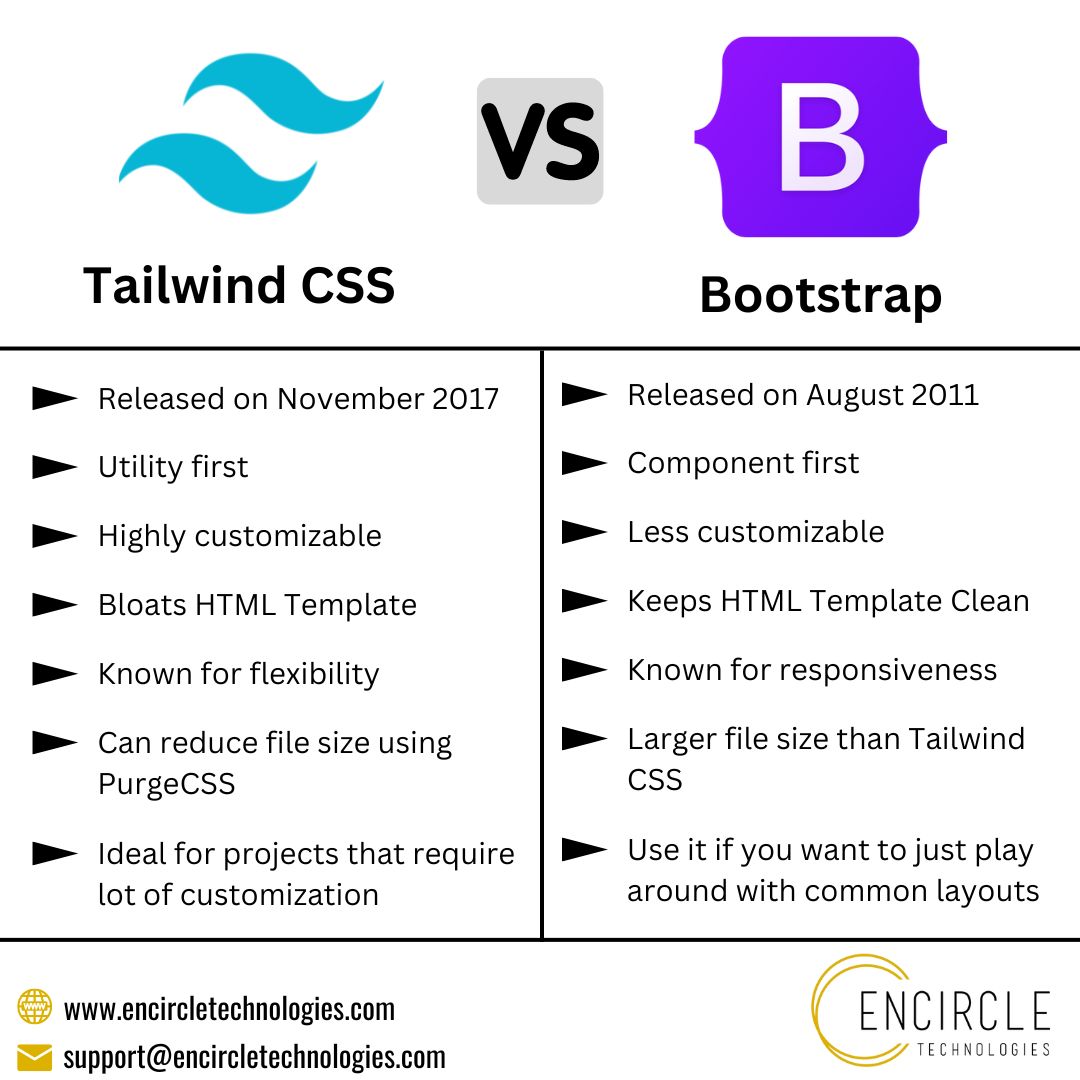If you are a web designer, you must have built websites using a popular CSS framework called Bootstrap. But, have you ever tried Tailwind CSS? Tailwind is a popular CSS framework which is gaining popularity in recent times.
Bootstrap is very popular among web designers & developers because it is a free and open-source CSS framework. The framework is used for developing responsive, mobile-first websites. It is older than Tailwind CSS (released in August 2011); it was built to design beautiful websites faster.
Talking about Tailwind CSS, it is a modern CSS framework. This utility-first CSS framework was built to create custom user interfaces efficiently. With Tailwind CSS, you get a large set of pre-defined utility classes that developers can use to quickly style their components without having to write custom CSS.
But since Tailwind CSS is quite a new framework, you might be wondering if it can replace Bootstrap? Whether you choose Bootstrap or Tailwind CSS, both frameworks have their own pros and cons.
Before we answer the main question, let’s talk a bit about both the frameworks.
About Bootstrap
Bootstrap is a popular CSS framework that was originally developed by Twitter. It provides developers with a set of pre-designed and pre-built components that can be used to quickly create responsive and mobile-first websites. Bootstrap solves the problem designers used to face when designing a website using Vanilla CSS.
Bootstrap is based on the CSS, HTML, and JavaScript programming languages, and it comes with a wide range of customizable elements, such as navigation bars, buttons, forms, modals, and carousels, among others. It also includes a powerful grid system that allows developers to create layouts that are optimized for different screen sizes, making it an ideal choice for designing responsive websites.
One of the main benefits of using Bootstrap is its ease of use. The framework is designed to be easy to learn and use, even for those who are new to web development. Its pre-built components and templates allow developers to quickly create high-quality websites without the need for extensive coding knowledge.
Bootstrap is also highly customizable, and developers can easily modify its pre-built components to fit their specific needs. The framework’s extensive documentation and active community of developers also make it easy for users to troubleshoot issues and learn new techniques.
Overall, Bootstrap is a powerful and versatile CSS framework that is ideal for building responsive and mobile-first websites.
About Tailwind CSS
Tailwind CSS is a popular utility-first CSS framework that allows developers to quickly create custom designs and layouts for their websites. Unlike other CSS frameworks that provide pre-built components, Tailwind CSS provides a set of CSS utility classes that can be used to create custom designs from scratch.
The framework includes a comprehensive set of utility classes that cover everything from colors and typography to layout and spacing. These classes are designed to be composable, meaning they can be combined to create complex designs without writing custom CSS.
Tailwind CSS is also highly customizable, and developers can easily modify its utility classes to fit their specific needs. The framework includes a configuration file that allows developers to customize the default values of colors, typography, and other design elements.
One of the main benefits of using Tailwind CSS is its efficiency. By using utility classes to style elements, developers can reduce the amount of custom CSS they need to write, which can save time and reduce file size. Additionally, the framework’s modular architecture allows developers to easily remove unused styles, further reducing file size.
Tailwind CSS is also designed to be responsive by default. The framework includes responsive variants of its utility classes, which allow developers to create layouts that adapt to different screen sizes without writing custom CSS.
Overall, Tailwind CSS is a powerful and flexible CSS framework that is ideal for developers who want to create custom designs and layouts quickly and efficiently. Its comprehensive set of utility classes, customization options, and accessibility features make it a popular choice for web developers of all skill levels.
Tailwind CSS Vs Bootstrap
Tailwind CSS and Bootstrap are both popular CSS frameworks that allow developers to create responsive and mobile-first websites. While they share some similarities, there are also significant differences between the two frameworks.

Is Tailwind CSS Better Than Bootstrap?
Now comes the main question, is Tailwind CSS better than Bootstrap?
Whether Tailwind CSS is better than Bootstrap depends on the specific needs of a project and the preferences of the developer. Both frameworks have their strengths and weaknesses, and choosing between them requires considering various factors such as project requirements, skillset, and personal preferences.
Bootstrap is a more established CSS framework with a larger user base, extensive documentation, and a wide range of pre-built components that allow developers to quickly create websites without needing to write custom CSS. Its grid system and responsive design features make it easy to create consistent and mobile-first layouts. However, Bootstrap can be less customizable than Tailwind CSS, and some developers may find its CSS classes too prescriptive and limiting.
On the other hand, Tailwind CSS provides developers with a comprehensive set of utility classes that can be combined to create custom designs and layouts. This approach offers more flexibility and allows developers to create unique designs without needing to write custom CSS. Tailwind CSS also has a smaller file size and is more efficient than Bootstrap, as it only generates the CSS that is used in the project. However, using Tailwind CSS requires more upfront configuration and can be more challenging for beginners to learn.
Ultimately, the choice between Tailwind CSS and Bootstrap depends on the specific needs of the project and the preferences of the developer. Both frameworks have their strengths and weaknesses, and developers should evaluate them based on the requirements of the project, the skill level of the team, and the desired design aesthetic.
